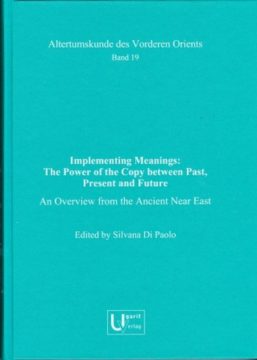Implementing Meanings. The Power of the Copy between Past, Present and Future. An Overview from the Ancient Near East, S. Di Paolo (ed.)
The modern era is characterised by a ‘challenged authenticity’ and a inauthoritative time that subverts both artisanal and authorial intervention. The suppression of the creative act in favour of multiple artworks differently inspired and destined to multiple viewers produces the displacement of the meaning of the artwork: they are not originals, nor strictly ‘copies’, but appropriations and adaptations for new contents and uses. Such concepts have also triggered new thoughts and a renewed research agenda on the relationship between Original and Copy in classical world. Through the renewed interest in the meaning of copies intended as producers of new knowledge available for multiple perspectives, as well as for different cultural, gendered, and ethnic identities new studies have highlighted that the apparent opposition between Original and Copy is not a modern invention.
For the first time, this book is focused on the topic of ‘Copy’ and its different connotations in ancient Near Eastern material culture: marker of social identity, medium with ideological and ritual purposes, educational and learning tool, product of technical achievements. At the same time, however, other flexible, dynamic and process-related aspects are examined: from the modern reproduction of artefacts for museum collections to stimulate public awareness, and appreciation of antiquity to the digitisation of archaeological artefacts to motivate personal experiences.The case-studies presented here explore different narrations resulting from ‘copied’ artefacts, thus promoting the culture of the copy and its transformative role in the ancient Near East. Copies assure value and continuity. Originality and uniqueness have been experienced making copies. Thus, an a world characterised by the reduction of the value of the distinction between unique and multiple, copying is able to convert the transitory into the timeless.
- Veröffentlicht am Donnerstag 8. März 2018 von Ugarit
- ISBN: 9783868352498
- 243 Seiten
- Genre: Antike, Geschichte, Sachbücher, Vor- und Frühgeschichte
